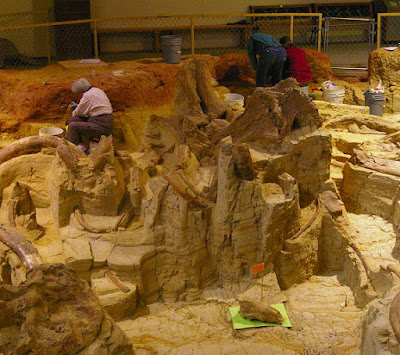 Above: Earthwatch volunteers excavate Columbian mammoth skeletons. The skull of a short-faced bear sits on the green sheet of paper at lower center.
Above: Earthwatch volunteers excavate Columbian mammoth skeletons. The skull of a short-faced bear sits on the green sheet of paper at lower center.Thirty-five years ago a bulldozer operator clearing ground for a subdivision on the edge of Hot Springs, South Dakota, grazed some Columbian mammoth bones—and realized that he had hit something important.
Today that spot is The Mammoth Site, a combination of working excavation, museum, laboratory, and gift shop.
Its structure covers a site that 25,000 years ago was a sinkhole that trapped dozens of mammoths who, perhaps while grazing in lush vegetation growing by the warm spring water, slipped in and could not climb out. (This was thousands of years before the accepted date of human arrival in North America.)
It is disquieting and sad, as M. noted, that all these big animals died struggling to breathe—except, perhaps, the short-faced bear. Did it climb down to gorge on mammoth meat and eat itself to death? Couldn't a big, agile bear make it up the slippery slope of decomposed shale? Or not?
It's a little touristy—get your mammoth hand puppets and key chains here—but definitely worth seeing.
•••
In other ancient proboscid news, a baby Siberian woolly mammoth found nearly intact has provided more information about the species not obtainable from fossils.
"We had no idea from preserved skeletons and preserved carcasses that young mammoths had a discrete structure on the back of the head of brown fat cells," said Prof [Daniel] Fisher.
Meanwhile, on June 1, 2009 two Colorado boys were poking around in a creek bed. They were not engaged in organized youth activities, mentored by adults and involving clear boundaries and a rulebook. They almost certainly were not wearing helmets.
"We were just thinking about walking up and down that stream and looking at the side of the banks to see if we see anything," said Tyler [Kellett] . "That would be fun."
They found a mastodon skeleton.
No comments:
Post a Comment